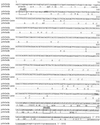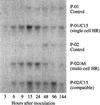Molecular characterization of the oxalate oxidase involved in the response of barley to the powdery mildew fungus
- PMID: 9576772
- PMCID: PMC35019
- DOI: 10.1104/pp.117.1.33
Molecular characterization of the oxalate oxidase involved in the response of barley to the powdery mildew fungus
Abstract
Previously we reported that oxalate oxidase activity increases in extracts of barley (Hordeum vulgare) leaves in response to the powdery mildew fungus (Blumeria [syn. Erysiphe] graminis f.sp. hordei) and proposed this as a source of H2O2 during plant-pathogen interactions. In this paper we show that the N terminus of the major pathogen-response oxalate oxidase has a high degree of sequence identity to previously characterized germin-like oxalate oxidases. Two cDNAs were isolated, pHvOxOa, which represents this major enzyme, and pHvOxOb', representing a closely related enzyme. Our data suggest the presence of only two oxalate oxidase genes in the barley genome, i.e. a gene encoding HvOxOa, which possibly exists in several copies, and a single-copy gene encoding HvOxOb. The use of 3' end gene-specific probes has allowed us to demonstrate that the HvOxOa transcript accumulates to 6 times the level of the HvOxOb transcript in response to the powdery mildew fungus. The transcripts were detected in both compatible and incompatible interactions with a similar accumulation pattern. The oxalate oxidase is found exclusively in the leaf mesophyll, where it is cell wall located. A model for a signal transduction pathway in which oxalate oxidase plays a central role is proposed for the regulation of the hypersensitive response.
Figures









Similar articles
-
An epidermis/papilla-specific oxalate oxidase-like protein in the defence response of barley attacked by the powdery mildew fungus.Plant Mol Biol. 1998 Jan;36(1):101-12. doi: 10.1023/a:1005955119326. Plant Mol Biol. 1998. PMID: 9484466
-
Structure, expression and localization of a germin-like protein in barley (Hordeum vulgare L.) that is insolubilized in stressed leaves.Plant Mol Biol. 1998 May;37(2):297-308. doi: 10.1023/a:1005982715972. Plant Mol Biol. 1998. PMID: 9617802
-
The Wheat Mediator Subunit TaMED25 Interacts with the Transcription Factor TaEIL1 to Negatively Regulate Disease Resistance against Powdery Mildew.Plant Physiol. 2016 Mar;170(3):1799-816. doi: 10.1104/pp.15.01784. Epub 2016 Jan 26. Plant Physiol. 2016. PMID: 26813794 Free PMC article.
-
Molecular studies on isopenicillin N synthases.Appl Microbiol Biotechnol. 2000 Jul;54(1):1-8. doi: 10.1007/s002530000347. Appl Microbiol Biotechnol. 2000. PMID: 10951997 Review.
-
Oxalate, germin, and the extracellular matrix of higher plants.FASEB J. 1994 Mar 1;8(3):294-301. doi: 10.1096/fasebj.8.3.8143935. FASEB J. 1994. PMID: 8143935 Review.
Cited by
-
Effect of yeast CTA1 gene expression on response of tobacco plants to tobacco mosaic virus infection.Plant Physiol. 2002 Jul;129(3):1032-44. doi: 10.1104/pp.010960. Plant Physiol. 2002. PMID: 12114558 Free PMC article.
-
The multigene family encoding germin-like proteins of barley. Regulation and function in Basal host resistance.Plant Physiol. 2006 Sep;142(1):181-92. doi: 10.1104/pp.106.083824. Epub 2006 Jul 14. Plant Physiol. 2006. PMID: 16844832 Free PMC article.
-
Reactive Oxygen Species Play a Role in the Infection of the Necrotrophic Fungi, Rhizoctonia solani in Wheat.PLoS One. 2016 Mar 31;11(3):e0152548. doi: 10.1371/journal.pone.0152548. eCollection 2016. PLoS One. 2016. PMID: 27031952 Free PMC article.
-
Development of expressed sequence tag and expressed sequence tag-simple sequence repeat marker resources for Musa acuminata.AoB Plants. 2012;2012:pls030. doi: 10.1093/aobpla/pls030. Epub 2012 Nov 26. AoB Plants. 2012. PMID: 23240072 Free PMC article.
-
The Structure of an Oxalate Oxidoreductase Provides Insight into Microbial 2-Oxoacid Metabolism.Biochemistry. 2015 Jul 7;54(26):4112-20. doi: 10.1021/acs.biochem.5b00521. Epub 2015 Jun 24. Biochemistry. 2015. PMID: 26061898 Free PMC article.
References
-
- Anderson MLM, Young BD. Quantitative filter hybridisation. In: Hames BD, Higgins SJ, editors. Nucleic Acid Hybridisation—A Practical Approach. Oxford, UK: IRL Press; 1985. pp. 73–111.
-
- Ausubel FM, Brent R, Kingston RE, Moore DD, Smith JA, Seidman JG, Struhl K (1987) Current Protocols in Molecular Biology 1987–1988. J Wiley & Sons, New York
-
- Baker JC, Orlandi EW. Active oxygen in plant pathogenesis. Annu Rev Phytopathol. 1995;33:299–321. - PubMed
-
- Berna A, Bernier F. Regulated expression of a wheat germin gene in tobacco: oxalate oxidase activity and apoplastic localization of the heterologous protein. Plant Mol Biol. 1997;33:417–429. - PubMed
-
- Bryngelsson T, Sommer-Knudsen J, Gregersen PL, Collinge DB, Ek B, Thordal-Christensen H. Purification, characterization and molecular cloning of basic PR-1-type pathogenesis-related proteins from barley. Mol Plant-Microbe Interact. 1994;7:267–275. - PubMed
Publication types
MeSH terms
Substances
Associated data
- Actions
LinkOut - more resources
Full Text Sources
Miscellaneous

